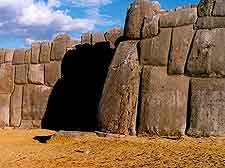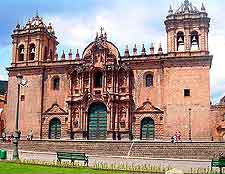Cusco History Facts and Timeline
(Cusco / Cuzco, Peru)

This city may be best known as the closest city to Peru's magnificent ancient site
Machu Picchu, but the history of Cusco itself is just as fascinating as that of the famous Inca monument some 80 km / 50 miles to its north-west.
Ancient Inca walls stand below many of Cusco's Spanish colonial buildings in the Inca Empire's former capital, now a UNESCO World Heritage site where people wearing traditional Quechua costume walk alongside modern partygoers after dark.
Killke Culture
The known history of Cusco begins with the Killke, who ruled the region for roughly three centuries, from 900 AD onwards. The Killke constructed the nearby impressive fortified settlement named Sacsayhuaman around about the year of 1100 AD. When the Incas conquered the city during the 13th century, they occupied the Sacsayhuaman area, which at that time included an aqueduct, a temple and a prominent thoroughfare.
Inca Conquest
During the Inca period of the history of Cusco, the city was divided into two main regions, named the 'hanan' and the 'urin', each of which comprised separate provinces. This successful and highly organised city plan was later duplicated in numerous other Inca cities. Rapid growth and good fortune saw it rise to become the mighty Tahuantinsuyu Empire. However, this brief prosperity came to an abrupt end when opposing Inca troops conquered Cusco during the 1532 Battle of Quipaipan. Just under two years later, the city was invaded by powerful Spanish conquistadors.
Spanish Colonisation
The Spanish arrived here just before the end of 1533 and soon began to colonise the city. Spanish colonel Francisco Pizarro González officially changed the city's spelling from Qusqu to Cusco, shortly after his arrival the following year. Less than two years later, Sapa Inca leader Manco Inca Yupanqui successfully recaptured the city, which led to a lengthy siege lasting almost an entire year.
The Spanish kept the original Inca walls largely intact when replacing existing temples with their own churches, and adapted many other buildings still standing in Cusco today, including the majority of the palaces. Several of these structures date as far back as the Killke era in the history of Cusco. The city quickly grew to become the centre for spreading Christianity and Spanish colonisation throughout Peru's south-east Andes region.

Independence and Machu Picchu Discovery
Following Peru's 1821 independence, Cusco continued to be an important regional centre. The city became the capital of its namesake 'department', which now stretches as far as Brazil's boundary line. Cusco grew even more dramatically after the 1911 discovery of the Machu Picchu ruins, which brought unprecedented numbers of tourists to the region, as well as the urban sprawl that now extends towards the Wanchaq and the Santiago neighbourhoods.
Earthquake Damage
Exactly three centuries after Cusco's last major earthquake in 1650, another earthquake destroyed over a third of the city's buildings in the very middle of the 20th century. Many of the buildings which survived the damage, however, actually date all the way back to the Inca era. Of real interest to history buffs, the 1950 earthquake unearthed walls and other Inca structures that had been hidden for literally centuries.
Modern Times in the City
Thanks in large part to its close proximity to Machu Picchu, Cusco has now become Peru's most popular tourist destination. In the year of 1983, it was proud to be named as a UNESCO World Heritage Site.
Lesser known archaeological ruins close to Cusco include the Chulquipalta sculpture garden, the city of Old Vilcabamba and the Inca Wasi site, which towers nearly 4 km / 2.5 miles above the Huatanay Valley.
 This city may be best known as the closest city to Peru's magnificent ancient site Machu Picchu, but the history of Cusco itself is just as fascinating as that of the famous Inca monument some 80 km / 50 miles to its north-west.
This city may be best known as the closest city to Peru's magnificent ancient site Machu Picchu, but the history of Cusco itself is just as fascinating as that of the famous Inca monument some 80 km / 50 miles to its north-west.